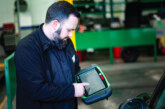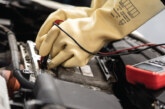How do tyre pressure monitoring systems work and would your fleet benefit from using them? Ian Jackson, of Continental Tyre Group, answers our questions.
Q. How much of a problem is under-inflation of tyres?
A. Research by Continental Tyres shows that as many as one in four truck tyres may be running underinflated by 10%. This not only leads to significantly higher fuel costs but contributes to the likelihood of tyre failure, which is currently responsible for 20% of all truck breakdowns.
■ 10% tyre under-inflation can increase fuel consumption by up to 3%
■ 90% of tyre-related breakdowns are preceded by undetected punctures
Q. What are the benefits to customers of using a Tyre Pressure Monitoring System (TPMS)?
A. Safety is of course the primary benefit as the system will pre-warn the driver of any temperature or inflation issues. Larger commercial vehicles obviously have quite a distance between where the driver is sitting and the tyres themselves, so it is important for them to be aware of the condition of their tyres.
A TPMS such as ContiPressureCheck provides live pressure data and additional warnings at the point where there has been both a 10% and then 20% reduction in air pressure inside the tyre, notifying the driver of a problem. It allows for the safe resolution of a potential tyre incident, enabling the driver to stop at a service station or off the road before the situation becomes critical.
Ideally, a TPMS will also constantly measure temperature. Spikes in temperature which, when investigated, cannot be attributed to the tyres then flag up potential mechanical issues such as binding brake or wheel bearing failures, which are costly and dangerous problems if left untreated.
As tyre inflation pressure directly contributes to the vehicle’s overall fuel efficiency, providing the ability to constantly monitor this offers the operator the opportunity to reduce their fuel costs.

Q. What are the benefits of using the ContiPressureCheck system specifically?
A. The main benefit is that the system is constantly transmitting live data, continually pre-empting any potential issues in real time.
The ContiPressureCheck system has been specifically designed from a tyre manufacturer’s point of view. We understand how a tyre behaves and what factors routinely affect its performance, so we built a TPMS with those in mind.
The sensor is attached to the inside of the tyre itself, which improves measurement accuracy. Devices which are strapped to a metal wheel rim will be more susceptible to heat transfer during braking, making it difficult to monitor the temperature effectively. Other systems, where sensors are attached to the valves, have the issue that the primary air seal is removed and instead rely entirely on the O-ring.
Q. What kind of fleet operation would benefit most from TPMS?
A. I genuinely believe all fleets could benefit. An operator running vehicles locally from a depot can install a reader which checks the vehicle every time it passes a certain point, or during refueling. A long-distance truck operator may prefer to have live data streamed to the driver.
It’s important to remember that a TPMS doesn’t need to be complicated. Our entry level system simply uses the sensors in the tyres and an easy-to-use handheld device. A quick walk round check once a week will enable an accurate pressure and temperature report to be generated for the whole fleet extremely quickly.
Q. Can TPMS be integrated with telematics systems?
A. Absolutely. It allows fleet managers to access live data from all their vehicles, reporting potential problems and generating reports that help optimise future tyre policy. It generates reports to ensure optimal tyre policy going forward and can also help manage trailer tyres by registering and checking them whenever the trailer is hooked up to a tractor unit.
Q. Is the system expensive to install?
A. The cost is around two to three hours of labour. For fleets with their own service engineers, Continental can provide the initial installation training. Alternatively, fitting can be done by our team of mobile fitting agents.
Q. What maintenance does ContiPressureCheck require once installed?
A. Absolutely no maintenance is required. If a wheel changes position, the system simply needs to be reconfigured via the handheld device. The sensors last approximately six years, or 600,000km, whichever comes first.
Q. What happens to the sensor when a tyre is changed?
A. The sensor comes in a rubber housing mounted inside the tyre. When the tyre needs replacing, the sensor is simply removed, fitted into a new housing and placed into the new tyre. If a new sensor is required and fitted, the system will evaluate all the sensors and, by default, recognise and accept the new addition.
Q. Do you think it would be beneficial for TPMS to become mandatory on commercial vehicles?
A. Without a doubt it would make the roads a far safer place. TPMS is essential to identify any potential inflation or temperature problems before they occur. Many commercial vehicle fires in the UK are as a direct result of mechanical faults such as binding brakes, so live temperature readings to alert the driver to the problem would make a huge difference.
Similarly, with rear wheels 6m back, there is little chance of the driver being able to gauge whether there is an inflation issue or a puncture in the tyre.
With adequate warning, drivers can safely pull in for repairs at a service station or safe site, rather than trying to fix a problem on the side of the road, which is in itself dangerous.










